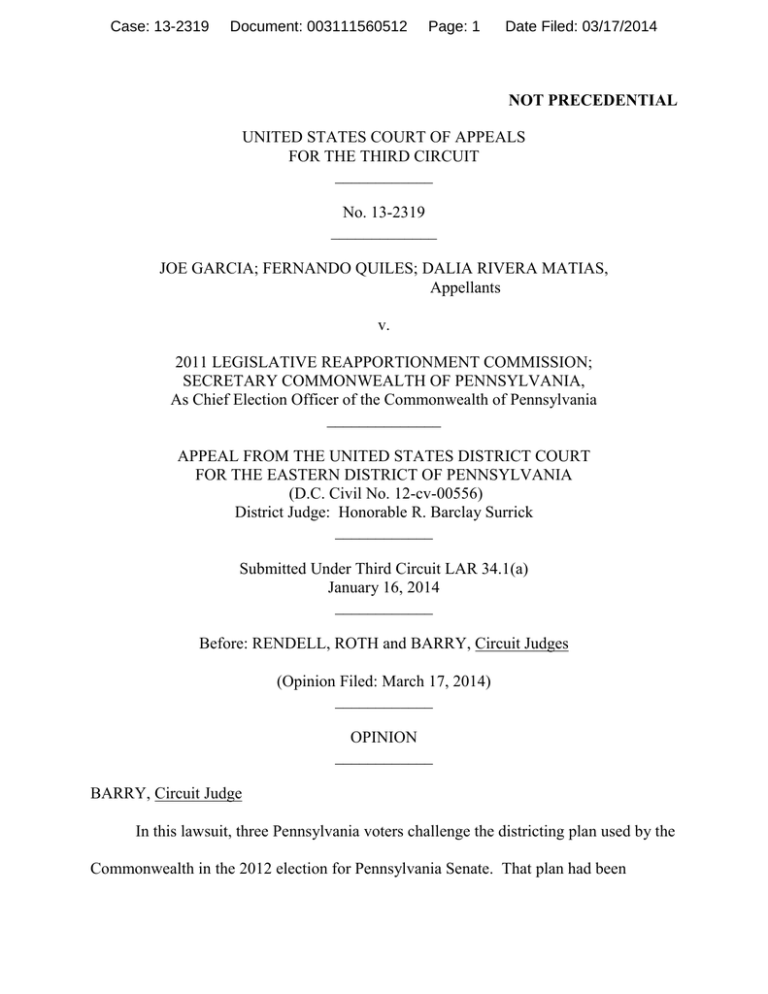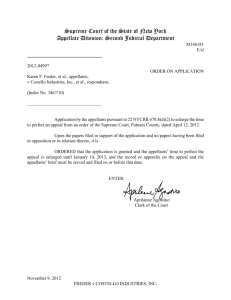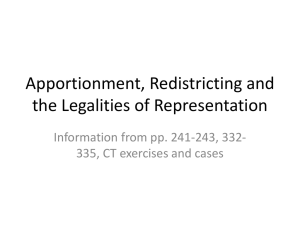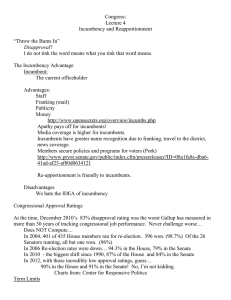NOT PRECEDENTIAL UNITED STATES COURT OF APPEALS FOR THE THIRD CIRCUIT
advertisement

Case: 13-2319 Document: 003111560512 Page: 1 Date Filed: 03/17/2014 NOT PRECEDENTIAL UNITED STATES COURT OF APPEALS FOR THE THIRD CIRCUIT ____________ No. 13-2319 _____________ JOE GARCIA; FERNANDO QUILES; DALIA RIVERA MATIAS, Appellants v. 2011 LEGISLATIVE REAPPORTIONMENT COMMISSION; SECRETARY COMMONWEALTH OF PENNSYLVANIA, As Chief Election Officer of the Commonwealth of Pennsylvania ______________ APPEAL FROM THE UNITED STATES DISTRICT COURT FOR THE EASTERN DISTRICT OF PENNSYLVANIA (D.C. Civil No. 12-cv-00556) District Judge: Honorable R. Barclay Surrick ____________ Submitted Under Third Circuit LAR 34.1(a) January 16, 2014 ____________ Before: RENDELL, ROTH and BARRY, Circuit Judges (Opinion Filed: March 17, 2014) ____________ OPINION ____________ BARRY, Circuit Judge In this lawsuit, three Pennsylvania voters challenge the districting plan used by the Commonwealth in the 2012 election for Pennsylvania Senate. That plan had been Case: 13-2319 Document: 003111560512 Page: 2 Date Filed: 03/17/2014 promulgated in 2001 based on population data from the 2000 U.S. census. The voters, plaintiffs before the District Court and appellants before us, contend that, by 2012, the Senate districts drawn in 2001 had become severely malapportioned in light of intervening population shifts and that use of the outdated districting map in the 2012 election violated the Equal Protection Clause’s one person, one vote principle.1 They sought an injunction in the District Court shortening the four-year term of all senators elected in 2012 and ordering that a special election be held to fill their seats. They also asked that a three-judge panel of the district court be assembled to adjudicate their claim. The Court rejected the requested relief and granted defendants’ motions to dismiss. We will affirm. I. A. BACKGROUND Pennsylvania’s 2011-2012 Legislative Reapportionment Process The Pennsylvania Constitution requires reapportionment of the Commonwealth’s General Assembly districts once every ten years, following each federal decennial census. Pa. Const. art. II, § 17(a). After each census, a Legislative Reapportionment Commission (“LRC”) is constituted to divide Pennsylvania into 50 senatorial and 203 representative districts. The LRC is required to file a preliminary reapportionment plan and then provide an opportunity for public comment and its own revision of the initial plan before adopting a final version. Once the LRC’s plan becomes final, any aggrieved 1 Before the District Court, plaintiffs also argued that use of the 2001 plan in the 2012 election resulted in the unconstitutional malapportionment of Pennsylvania House of Representatives districts and unlawfully diluted the votes of Latino voters in violation of the Voting Rights Act. They do not pursue these claims on appeal. 2 Case: 13-2319 Document: 003111560512 Page: 3 Date Filed: 03/17/2014 person may file an appeal directly to the Pennsylvania Supreme Court, which has final approval authority. After the Supreme Court has denied any outstanding appeals or the last day for filing an appeal has passed with no appeal taken, the final reapportionment plan “shall have the force of law and the districts therein provided shall be used thereafter in elections to the General Assembly until the next [constitutionally required] reapportionment.” Id. § 17(e). On December 21, 2010, the U.S. Census Bureau reported national and state population counts from the 2010 federal census, triggering the start of Pennsylvania’s reapportionment process. The LRC was fully assembled in April 2011, and filed its preliminary reapportionment plan on October 31, 2011. After entertaining comments and objections from members of the public and making its own technical corrections to the preliminary plan, the LRC approved a final plan (the “2011 Final Plan”) at a public administrative meeting on December 12, 2011. Twelve petitions challenging the 2011 Final Plan were filed with the Pennsylvania Supreme Court. On January 25, 2012, following expedited briefing and oral argument, the Supreme Court issued an order declaring that the 2011 Final Plan was “contrary to law” and remanding the plan to the LRC with instructions to reapportion the Commonwealth. Holt v. 2011 Legislative Reapportionment Comm’n, 38 A.3d 711, 71516 (Pa. 2012) (per curiam order). The Court’s order stated that the 2001 plan adopted after the 2000 U.S. census would “remain in effect until a revised final 2011 Legislative Reapportionment Plan having the force of law is approved.” Id. at 716. 3 Case: 13-2319 Document: 003111560512 Page: 4 Date Filed: 03/17/2014 The LRC issued a revised plan on April 12, 2012, and, after timely exceptions were filed, adopted its revised plan as final on June 8, 2012 (the “2012 Final Plan”). Thirteen appeals challenging the 2012 Final Plan were lodged with the Pennsylvania Supreme Court. On May 8, 2013, the Supreme Court approved the 2012 Final Plan, giving it “the force of law.”2 Holt v. 2011 Legislative Reapportionment Comm’n, 67 A.3d 1211, 1242-43 (Pa. 2013) (“Holt II”); see Pa. Const. art. II, § 17(e). B. The 2012 Senate Election Meanwhile, as the LRC worked to create a new reapportionment plan in the wake of the Supreme Court’s remand, the 2012 elections for General Assembly, the first to take place after the release of the 2010 U.S. census results, proceeded under the 2001 plan. Elections for Pennsylvania Senate occur each even-numbered year, with senators elected to serve staggered four-year terms. Each cycle, half of the Senate stands for election. In 2012, voters in odd-numbered districts elected senators to terms commencing December 1, 2012. Senatorial seats assigned to even-numbered districts were previously filled in 2010 under the 2001 plan. Even-numbered seats will next be filled in 2014 in accordance with the 2012 Final Plan and those elected will serve four-year terms beginning December 1, 2014. C. The Appellants’ Suit Appellants are three registered Pennsylvania voters who challenge the use of the 2001 reapportionment plan in the 2012 Senate elections. According to the 2010 2 Appellants do not challenge the constitutionality of the 2012 Final Plan. 4 Case: 13-2319 Document: 003111560512 Page: 5 Date Filed: 03/17/2014 decennial census, Pennsylvania’s population had increased to 12,702,379, meaning that, to achieve equally populated senatorial districts, each of the 50 districts should contain approximately 254,048 individuals. Continued use of district boundaries drawn in 2001 meant that, as of 2012, certain Senate districts deviated markedly from this target population. Consequently, voters in more-populated districts were underrepresented in the Senate and the effectiveness of any votes cast by these individuals in the 2012 Senate election were, comparatively, worth less than the votes cast by individuals in lesspopulated districts. Appellants, all of whom reside in overpopulated districts, contend that this level of deviation in district size amounts to unconstitutional malapportionment in violation of the Equal Protection Clause of the Fourteenth Amendment. They also argue that the LRC unduly delayed issuing a preliminary reapportionment plan, ensuring that the 2012 election would be held under the old apportionment scheme. Although appellants challenge the manner in which the 2012 senatorial election was conducted, all three of them are residents of even-numbered districts and, therefore, could not have voted in that election, in which only senators from odd-numbered districts were selected. Two of the appellants live in Philadelphia, located in Pennsylvania’s 2nd Senatorial District, and the third lives in Allentown, located in the 16th Senatorial District. Appellants filed their complaint on February 2, 2012, naming the LRC and Secretary of the Commonwealth Carol Aichele as defendants. That June, appellants filed a motion for a preliminary injunction, requesting (1) a shortened term for any 5 Case: 13-2319 Document: 003111560512 Page: 6 Date Filed: 03/17/2014 Pennsylvania legislator elected in 2012 pursuant to the 2001 reapportionment plan and (2) a special election for their seats to be held in accordance with a new reapportionment plan. Appellants also requested that a three-judge panel of the district court be convened to adjudicate their claims. The LRC and the Secretary filed motions to dismiss. On April 5, 2013, the District Court, sitting as a single judge, concluded that use of the 2001 reapportionment plan in the 2012 elections, while the process of approving a new plan was ongoing, did not run afoul of the Equal Protection Clause. Finding appellants’ constitutional claim “insubstantial,” the Court denied the motion for a preliminary injunction and granted the motions to dismiss without convening a threejudge panel. (App. at 23.) Appellants appeal the District Court’s decision not to appoint a three-judge panel, its denial of their motion for a preliminary injunction, and its grant of the Secretary’s motion to dismiss.3 II. JURISDICTIONAL BASIS AND STANDARD OF REVIEW The statutory basis for the District Court’s jurisdiction was 28 U.S.C. §§ 1331 and 1343, and our jurisdiction, if constitutionally proper, arises under 28 U.S.C. § 1291. We exercise plenary review over the District Court’s decision not to convene a three-judge panel. Page v. Bartels, 248 F.3d 175, 192 n.11 (3d Cir. 2001). According to 3 The LRC was initially an appellee in this case. After the notice of appeal was filed, the Pennsylvania Supreme Court issued its decision in Holt II approving the LRC’s 2012 Final Plan. According to appellants, that decision mooted any relief they sought from the LRC, and, pursuant to a stipulation, we subsequently dismissed the LRC as a party to this appeal. 6 Case: 13-2319 Document: 003111560512 Page: 7 Date Filed: 03/17/2014 28 U.S.C. § 2284(a), in general, a three-judge panel of the district court must be convened “when an action is filed challenging the constitutionality of . . . the apportionment of any statewide legislative body.” In such a suit, a single district court judge is not permitted to “hear and determine any application for a preliminary or permanent injunction . . . or enter judgment on the merits.” Id. § 2284(b)(3). A panel of three judges need not be assembled, however, and a single judge of the district court may issue a ruling on the merits where “the plaintiffs’ constitutional challenge was legally frivolous and insubstantial.” Page, 248 F.3d at 191 (citing Goosby v. Osser, 409 U.S. 512, 518 (1973); Bailey v. Patterson, 369 U.S. 31, 33 (1962) (per curiam)). It is also necessary for us to consider appellants’ standing to bring their malapportionment claim, an issue not addressed by the District Court. Before any federal appellate court can examine the merits of a claim, it must be satisfied that both it has and the lower court had subject matter jurisdiction. Steel Co. v. Citizens for a Better Env’t, 523 U.S. 83, 94-95 (1998); Bender v. Williamsport Area Sch. Dist., 475 U.S. 534, 541 (1986). A court has this “independent obligation to determine whether subject matter jurisdiction exists, even if its jurisdiction is not challenged.” Nuveen Mun. Trust ex rel. Nuveen High Yield Mun. Bond Fund v. WithumSmith Brown, P.C., 692 F.3d 283, 293 (3d Cir. 2012) (citing Arbaugh v. Y & H Corp., 546 U.S. 500, 514 (2006)). Proper jurisdiction exists only where the dispute constitutes a “case” or “controversy” within the meaning of Article III, which, in turn, requires that the plaintiffs have standing to sue. Raines v. Byrd, 521 U.S. 811, 818 (1997). The burden of establishing standing belongs 7 Case: 13-2319 Document: 003111560512 Page: 8 Date Filed: 03/17/2014 to the plaintiff. Berg v. Obama, 586 F.3d 234, 238 (3d Cir. 2009). Jurisdiction may be called into question, as we do here, based on the insufficiency of the allegations in a complaint. In such a case, we must accept the allegations of the complaint as true and determine whether they are sufficient to invoke federal-court jurisdiction. Taliaferro v. Darby Twp. Zoning Bd., 458 F.3d 181, 188 (3d Cir. 2006). III. ANALYSIS After receiving briefing on the merits of appellants’ malapportionment claim, which appeared to be based on an alleged dilution of their votes in the 2012 Pennsylvania Senate election, we sua sponte directed the parties to provide supplemental memoranda addressing whether they have standing to bring such a claim, given that they are residents of even-numbered districts and were not eligible to vote in the 2012 election. Our concerns regarding standing were warranted. We find that appellants lack standing to pursue a claim of vote dilution with respect to the 2012 senatorial election. Even if, however, their malapportionment claim is based on ongoing underrepresentation in the Pennsylvania Senate, an injury sufficient to establish standing, and not the debasement of votes cast in a specific election, the District Court appropriately dismissed that claim. A. Constitutional Apportionment Standard The Fourteenth Amendment’s Equal Protection Clause obliges the states to count equally the votes of its citizens. Reynolds v. Sims, 377 U.S. 533, 560-64 (1964). Accordingly, state legislative districts must be as equal in population as is practicable, thereby ensuring substantially equal representation for all citizens and substantially 8 Case: 13-2319 Document: 003111560512 Page: 9 Date Filed: 03/17/2014 equally weighted votes in legislative elections. As a corollary to this mandate, “an individual’s right to vote for state legislators is unconstitutionally impaired when its weight is in a substantial fashion diluted when compared with votes of citizens living [in] other parts of the State.” Id. at 568. Of course, the Supreme Court has recognized that strict adherence to a one person, one vote rule in the context of state districting is neither possible nor, in all instances, desirable. Brown v. Thomson, 462 U.S. 835, 842 (1983); Gaffney v. Cummings, 412 U.S. 735, 743-49 (1973). And the Constitution does not inflexibly require states to redraw constantly their legislative districts in order to maintain even populations in the face of ever-changing demographics. Reynolds, 377 U.S. at 583-84. Instead, states may enact “a reasonably conceived plan for periodic readjustment of legislative representation.” Id. at 583. The Supreme Court in Reynolds made clear that compliance with a decennial reapportionment scheme is sufficient to pass constitutional muster but less frequent apportionment “would assuredly be constitutionally suspect.” Id. at 583-84. B. Standing in Apportionment Cases To demonstrate constitutional standing, a plaintiff must show (1) an “injury in fact” that is (a) “concrete and particularized” and (b) “actual and imminent, not conjectural or hypothetical”; (2) that the injury is “fairly traceable to the challenged action of the defendant”; and (3) that it is “likely,” rather than speculative, “that a favorable judicial decision will prevent or redress the injury.” Summers v. Earth Island Inst., 555 U.S. 488, 493 (2009) (quotation marks omitted); Friends of the Earth, Inc. v. 9 Case: 13-2319 Document: 003111560512 Page: 10 Date Filed: 03/17/2014 Laidlaw Envtl. Servs. (TOC), Inc., 528 U.S. 167, 180-81 (2000). These requirements, including the need to demonstrate “injury in fact,” are no less applicable in the apportionment context. Although all those in a covered district are impacted by malapportionment, not everyone is injured. Indeed, as Reynolds makes plain, the detrimental effect of malapportionment is not simply a generalized harm to the polity. Malapportionment’s harm is felt by individuals in overpopulated districts who actually suffer a diminution in the efficacy of their votes and their proportional voice in the legislature. See, e.g., Reynolds, 377 U.S. at 561-63 (framing uneven districting as a form of “invidious discrimination” based on geographic location that abridges the voting rights of individuals in “disfavored areas,” because “[o]verweighting and overvaluation of the votes of those living here has the certain effect of dilution and undervaluation of the votes of those living there”). To challenge a state’s apportionment scheme, therefore, an individual must belong to the injured class of people whose votes and representational voice receive less than their fair share. See Fairley v. Patterson, 493 F.2d 598, 603-04 (5th Cir. 1974) (relying on the Supreme Court’s holding in Baker v. Carr, 369 U.S. 186, 206-08 (1962), that underrepresentation in a plan of apportionment is an injury sufficient to confer standing); accord Wright v. Dougherty Cnty., 358 F.3d 1352, 1355 (11th Cir. 2004) (per curiam); League of Women Voters v. Nassau Cnty. Bd. of Supervisors, 737 F.2d 155, 161-62 (2d Cir. 1984); Skolnick v. Bd. of Comm’rs, 435 F.2d 361, 363-64 (7th Cir. 1970). Moreover, a voter who has not been injured lacks standing to sue on behalf of individuals who are 10 Case: 13-2319 Document: 003111560512 Page: 11 Date Filed: 03/17/2014 actually injured by a plan of apportionment. See Wright, 358 F.3d at 1355. C. Application Appellants’ claim is clear: Pennsylvania’s failure to implement a new apportionment plan based on 2010 census data and the continued use of an outdated district map in the 2012 Senate election violated the constitutional principle of one person, one vote. Less evident from the complaint and appellants’ briefing before us is exactly how they, in particular, were aggrieved by untimely reapportionment. Appellants’ reply brief supplies the clearest articulation of their claim. There, they several times assert that the delay in adoption of a new apportionment plan abridged their “right to participate” in an election “on an equal basis with other citizens.” Appellants’ Reply Br. at 1, 5-7 & n.1. In essence, appellants contend that they were denied the ability to cast a vote of equal weight in the 2012 election because they lived in overpopulated, but identically represented, districts. Given Pennsylvania’s staggered method of electing senators, however, no appellant could have voted for senator in the 2012 election, as they all reside in evennumbered districts. Only voters in odd-numbered districts selected senators in 2012. Thus, appellants cannot argue that they were injured in fact through unfair dilution of their votes in 2012, the salient factor in the courts of appeals’ cases building on Baker’s standing analysis. See, e.g., Wright, 358 F.3d at 1355; League of Women Voters, 737 F.2d at 161-62. Nor, for that matter, do appellants explain how enactment of a new apportionment 11 Case: 13-2319 Document: 003111560512 Page: 12 Date Filed: 03/17/2014 plan prior to the 2012 election would have safeguarded their right to cast an undiluted ballot, such that an equal protection claim is traceable to the LRC’s delay. They do not contend, for instance, that, if the 2012 Final Plan or some other plan had been implemented before the 2012 election, they would have been moved into a wellapportioned, odd-numbered district and been able to vote for a senator in that election. Appellants, therefore, lack standing to bring a claim of unconstitutional vote dilution with respect to the 2012 senatorial election, and any claim founded on this basis is “legally frivolous and insubstantial.” Page, 248 F.3d at 191. In their supplemental briefing, and in response to our expressed concern as to standing, appellants press a modified vision of their claim. They argue that Pennsylvania’s failure to reapportion its Senate districts within ten years of the 2001 apportionment relegated them to overpopulated districts in violation of their constitutional right to representational equality. According to appellants, because the 2012 election was conducted pursuant to an outdated district map, it perpetuated unequal and, with respect to them, diluted Senate representation beyond the ten-year timeframe for reapportionment discussed in Reynolds. We need not decide the ultimate merits of such an equal protection claim. Federal courts must exercise caution before inserting themselves into a state’s districting process, as it is a political matter primarily within the authority of the states themselves. Cf. Growe v. Emison, 507 U.S. 25, 33-34 (1993) (directing federal courts to defer their consideration of apportionment disputes to permit redistricting by state legislatures and 12 Case: 13-2319 Document: 003111560512 Page: 13 Date Filed: 03/17/2014 courts); Gaffney, 412 U.S. at 749-50 (warning federal courts against modifying state apportionment plans that contain modest deviations in district populations). Courts must also take stock of general equitable principles, “the circumstances of the challenged apportionment[,] and a variety of local conditions” in attempting to redress any injury wrought by malapportionment. Reynolds, 377 U.S. at 585. Here, even assuming that Pennsylvania’s delayed apportionment runs afoul of constitutional standards, there is ample reason for us to decline to venture into the Commonwealth’s redistricting process. Appellants stress their need for an injunction ordering that senators elected in 2012 serve a shortened two-year term and that a special election, coinciding with the regularly scheduled 2014 Senate election, be held to fill odd-numbered Senate seats. But that will not remedy their alleged injury of continued representational inequality. Regardless of whether the senators in odd-numbered districts stand for special election in 2014, the 2014 election for even-numbered districts will be conducted in accordance with the new electoral map (the 2012 Final Plan, which appellants do not challenge) and, in fact, by 2014, it appears that all senators will be assigned to represent redrawn and equally sized districts under that plan, which now has “the force of law.” Pa. Const. art. II, § 17(e). In other words, even without intervention by the federal courts, by 2014, appellants will be placed in evenly apportioned districts and enjoy equal representation. Because the remedy they seek will do nothing to effectuate more speedily their rights, we will affirm the District Court’s order of dismissal. 13 Case: 13-2319 Document: 003111560512 IV. Page: 14 Date Filed: 03/17/2014 CONCLUSION For the foregoing reasons, we will affirm the order of the District Court declining to refer this matter to a three-judge panel, denying appellants’ motion for a preliminary injunction, and granting Secretary Aichele’s motion to dismiss. 14





